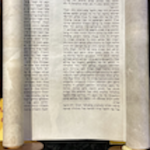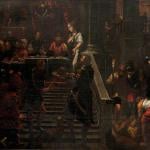Friend of Wild Goose, Peter Rollins, has a new book out called Insurrection. It might just challenge everything we think about faith and the world we inhabit. Here’s an extract:
Each epoch in the life of the Church arises from the white-hot fires of a fundamental question, a question that burns away the husk that was once thought to be essentialin order to reveal once more the revolutionary event heralded by Christ’s Crucifixion and Resurrection. Such questions do not address the vast sea of disagreements that exist within the shared theological horizon of an era but challenge the very ho- rizon itself. They place into question the various assumptions that these groups all take for granted. They cut across what is assumed, short-circuit what is hallowed, and, in so doing, appear on the scene as a profound threat to the very essence of Christianity. They offer us a unique opportunity to rethink what it means to be the Church, not merely critiquing the presently existing Church for failing to live up to its ideals, but rather for espousing the wrong ideals.
The first question of this kind was related to the issue of circumcision. At the very founding of the Church, a heated debate broke out concerning whether or not this outward sign was a requirement for Gentile converts. This was a controversial issue at the time, but when the dust finally settled, a decision had been made. New converts would not need to undergo circumcision in order to participate in the full life of the Church. This decision, known as the “Apostolic Decree,” was revolutionary and helped to establish the unique identity of the Christian community. More than this, it helped bring to light the idea that faith concerned a total life transformation rather than some outward mark.
There have been various pivotal debates like this one over the life of the Church, debates that gave rise to monasticism, that provoked the split between Eastern and Western branches of Christianity, and that spawned the Protestant Reformation. Like the discussions concerning circumcision, each of these historical de- bates marked a radical transformation in the Church of its day. As such we may link them directly to what gave rise to the Apostolic Decree by calling them “Circumcision Questions.”Giving them this name not only links them directly to the first fundamental question that arose in the Christian community but also refers to the nature of these questions as such, for they are never concerned with addition (working out what needs to be added to the message as it currently stands) but with subtraction (debating what needs to be cut away). A circumcision question asks us to remove something previously thought of as vital in order to help unveil, in an apocalyptic way, the central scandal of Christianity.
In this book I suggest that we stand once more at the thresh- old of such a question, a question that houses the power to provoke a rupturing and re-configuring of the present manifestation of Christianity. It is an incendiary question that houses the very power to set the Church alight, burning away the rot to reveal that which cannot be consumed. This is why the task of working through a circumcision question can never be described as some project in constructive theology; it is a work of pyro-theology.
While circumcision questions attempt to bring us back to a central truth-event of faith, we must not confuse them with the reactionary movements that seek to return to the early Church— the Church in some more ancient, and supposedly purified, form. There are those who want to go back to the way the Church was before Constantine, when it is thought that religious authorities became extensions of the State. There is an attempt to return to the Church before the influence of Neo-Platonism when, those people say, Greek philosophy perverted the message. And there are even those who want to return to the Church before Paul—who some believe reduced the message of Christ to a set of rules and dogmas. Such moves, however, fall short, not because they go back too far, but because they fail to go back far enough.
The truly revolutionary move is not to chart a return to the early Church, but to the event that gave birth to the early Church.
The return called for by circumcision questions is not concerned with some stretching back into the past, for the event that gave birth to the early Church is present now. It is not lost in some long-forgot- ten era to be unearthed anew but rather dwells as an ever-present potential that we are invited to make actual in our bodies. In the aftermath of a circumcision question, an expression of Church life arises that may look utterly different from anything that went before it, yet it is fed by the same blood that pulsed through the old, remaining true to it by advancing boldly into the new.
So what is the question that presents itself at this time in the history of Christianity? What is this point from which we may gain the leverage to overturn the Church as it presently stands (in its conservative, liberal, evangelical, fundamentalist, and orthodox forms)?
The theologian Dietrich Bonhoeffer succinctly articulated the answer shortly before his execution by the Nazis. In a compilation of his personal correspondence entitled Letters and Papers from Prison, he wrote of how the question for us today is whether or not religion is necessary in order to participate fully in the life testified to by Christ. For Bonhoeffer, religion at its most basic defined a particular way of thinking about and relating to God, a way of approaching God as the solution to problems such as fear, ignorance, or despair. He wrote of the next epoch in Church life as one that would utterly transcend this impotent God whose only job is to provide us with a psychological crutch (what we will call the God of religion, or the religious God) and usher in what he called “religionless Christianity.” Bonhoeffer was executed before he was able to develop his project, and we are left with only fragments of his vision, frag- ments that are pregnant with possibility.
In Insurrection, I endeavor to outline what this radical expres- sion of a faith beyond religion might look like and how it has the power to give birth to a radically new form of Church, one with the power to renew, reform or even transcend the present constellation of conservative, liberal, evangelical, fundamentalist, and orthodox communities.
This work of pyro-theology will involve outlining the present understanding of God, exploring the way Crucifixion and Resurrection open up a different reality, and charting what might arise should we be courageous enough to step into this reality.The following will not be an easy read; many will find it disturbing, for some of the things we hold precious will be attacked from the very outset. But it is written with a firm conviction that we must not be afraid to burn our sacred temples in order to dis- cover what, if anything, remains.
Indeed, perhaps it is not what remains after the fire has died that is true, but rather the fire itself. If so, then we need to take the words of Spanish anarchist Buenaventura Durruti seriously when he boldly declares: The only church that illuminates is a burning one.
Insurrection is available at the usual places – but here’s a link to one of our favorite bookstores.











